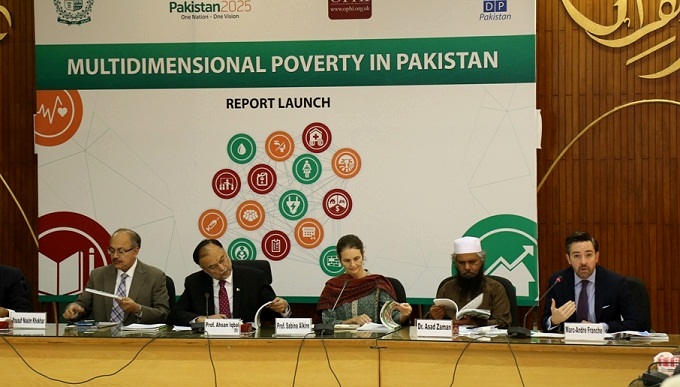People in FATA and Balochistan living in extreme multidimensional poverty whereas poverty ratio in KPK is at 49%, Gilgit-Baltistan and Sindh at 43%, Punjab at 31% while the rate is lowest in Azad Jammu and Kashmir at 25%
ISLAMABAD – Around 39 percent of Pakistanis live in multidimensional poverty, with FATA and Balochistan have the highest rates of poverty, according to Pakistan’s official Multidimensional Poverty Index (MPI).
Pakistan’s first ever official report on multidimensional poverty was launched by the Ministry of Planning, Development and Reform. The report details Pakistan’s official Multidimensional Poverty Index (MPI) which was earlier published in the Economic Survey of Pakistan 2015–2016. The report has been compiled with technical support from UNDP Pakistan and the Oxford Poverty and Human Development Initiative (OPHI), University of Oxford.
According to the report, nearly 39 percent of Pakistanis live in multidimensional poverty, with the highest rates of poverty in FATA and Balochistan. Pakistan’s MPI showed a strong decline, with national poverty rates falling from 55% to 39% from 2004 to 2015. However, progress across different regions of Pakistan is uneven. Poverty in urban areas is 9.3 percent as compared to 54.6 percent in rural areas. Disparities also exist across provinces.
The report found that over two-thirds of people in FATA (73 percent) and Balochistan (71 percent) live in multidimensional poverty. Poverty in Khyber Pakhtunkhwa stands at 49 percent, Gilgit-Baltistan and Sindh at 43 percent, Punjab at 31 percent and Azad Jammu and Kashmir at 25 percent.
There are severe differences between districts: Islamabad, Lahore and Karachi have less than 10 percent multidimensional poverty, while Qila Abdullah, Harnai and Barkhan (all in Balochistan) have more than 90 percent poverty. Deprivation in education contributes the largest share of 43 percent to MPI followed by living standards which contributes nearly 32 percent and health contributing 26 percent.
The Report findings further confirm that social indicators are very weak in Pakistan, even where economic indicators appear healthy. The report also found that the decrease in multidimensional poverty was slowest in Balochistan, while poverty levels had actually increased in several districts in Balochistan and Sindh during the past decade. The level and composition of multidimensional poverty for each of Pakistan’s 114 districts are also covered in this report.

Speaking at the launch, the Minister for Planning, Development and Reform, Professor Ahsan Iqbal, said that the reduction of multidimensional poverty is one of the core objectives of Pakistan’s Vision 2025. “Inclusive and balanced growth, which benefits everyone and especially the marginalized communities, is government priority and is essential for promoting harmony in society” he said.
MPI is a useful instrument for inform public policy for targeting, budgeting, resource allocation and inclusion. Pakistan’s MPI establishes baseline not for only Vision 2025, but also for Pakistan’s progress towards achieving the Sustainable Development Goals, and complements the consumption-based poverty estimates recently released by the Government of Pakistan, Ahsan Iqbal added.
Marc-André Franche, UNDP Country Director said, “We consider this a highly innovative approach because of its multi-faceted nature and the availability of estimates at the sub-national level. Multidimensional poverty provides useful analysis and information for targeting poverty, and reducing regional inequalities. Many countries are using MPI to inform government priorities for planning and it is encouraging to see Government of Pakistan adopting MPI to complement monetary poverty measure in Pakistan.”
Dr Sabina Alkire, Director OPHI, congratulated Pakistan on launching the national MPI as an official poverty measure. “Developed with input from all provinces, Pakistan’s MPI is very robust and we have been very pleased to work alongside the very strong academic and policy community in Pakistan. Pakistan’s leadership will be of interest to over 40 other countries in the Multidimensional Poverty Peer Network who are using multidimensional poverty measures in the Sustainable Development Goals” she said.
The Multidimensional Poverty Index uses a broader concept of poverty than income and wealth alone. It reflects the deprivations people experience with respect to health, education and standard of living, and is thus a more detailed way of understanding and alleviating poverty. Since its development by OPHI and UNDP in 2010, many countries, including Pakistan, have adopted this methodology as an official poverty estimate, complementing consumption or income-based poverty figures.

